Australian Accounting Standards Analysis: ACC201 Financial Accounting
VerifiedAdded on 2022/09/15
|10
|1575
|21
Report
AI Summary
This report provides an analysis of Australian Accounting Standards (AAS) based on the provided assignment questions. The report begins with an executive summary and table of contents, followed by an introduction that outlines the scope of the analysis. The discussion section provides solutions to three assessment questions. The first question addresses the amortization of intangible assets under AASB 138/IAS 38, highlighting the criteria for asset recognition and the difficulties faced by standard setters. The second question focuses on goodwill, explaining its recognition, impairment, and the implications of significant write-offs. The third question examines accounting for restructuring provisions as per AASB 137, including when a provision should be recognized and the decision-making process when closing a division. The report concludes by summarizing the key findings and referencing relevant literature.

Running head: AUSTRALIAN ACCOUNTING STANDARD ANALYSIS
Australian Accounting Standard Analysis
Name of the Student:
Name of the University:
Author Note:
Australian Accounting Standard Analysis
Name of the Student:
Name of the University:
Author Note:
Paraphrase This Document
Need a fresh take? Get an instant paraphrase of this document with our AI Paraphraser
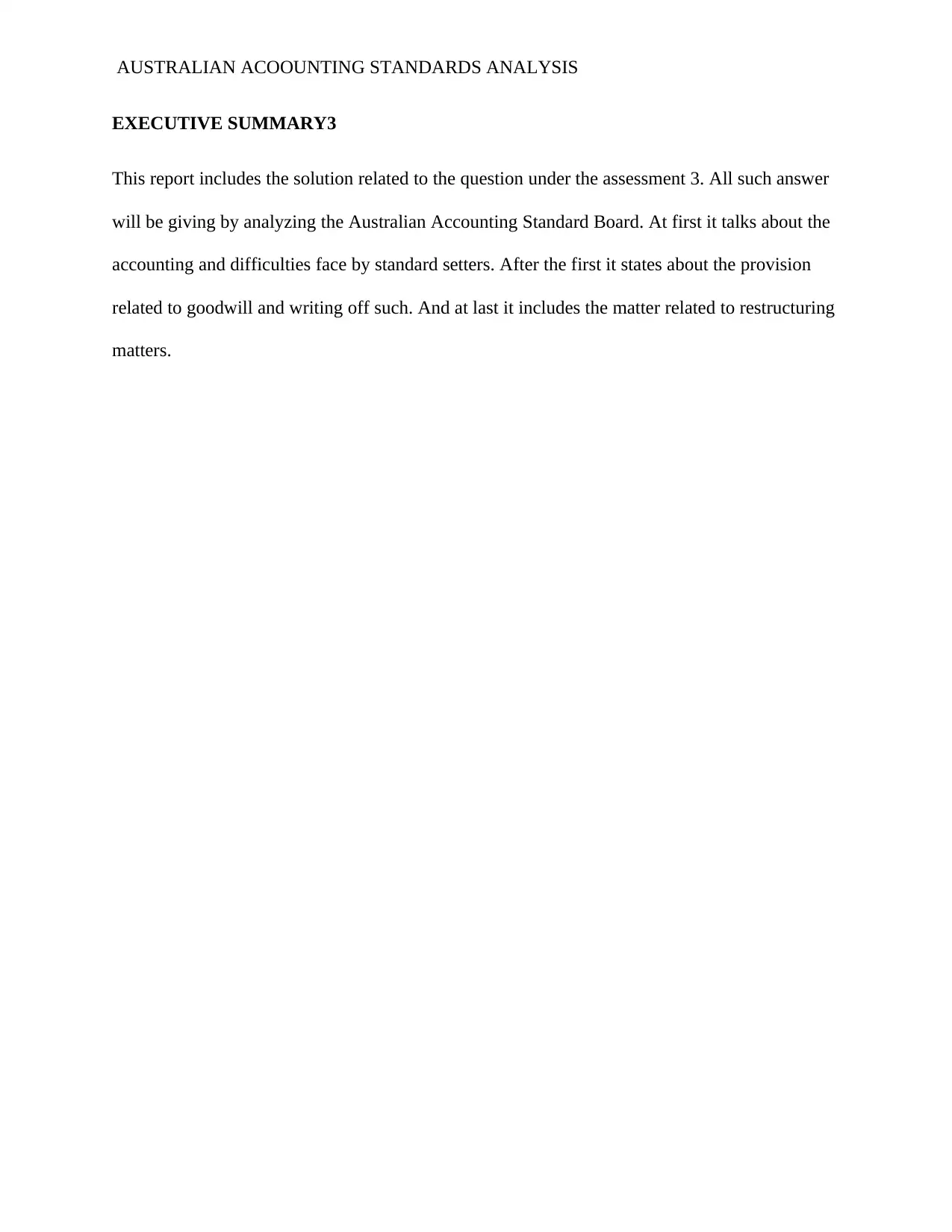
AUSTRALIAN ACOOUNTING STANDARDS ANALYSIS
EXECUTIVE SUMMARY3
This report includes the solution related to the question under the assessment 3. All such answer
will be giving by analyzing the Australian Accounting Standard Board. At first it talks about the
accounting and difficulties face by standard setters. After the first it states about the provision
related to goodwill and writing off such. And at last it includes the matter related to restructuring
matters.
EXECUTIVE SUMMARY3
This report includes the solution related to the question under the assessment 3. All such answer
will be giving by analyzing the Australian Accounting Standard Board. At first it talks about the
accounting and difficulties face by standard setters. After the first it states about the provision
related to goodwill and writing off such. And at last it includes the matter related to restructuring
matters.
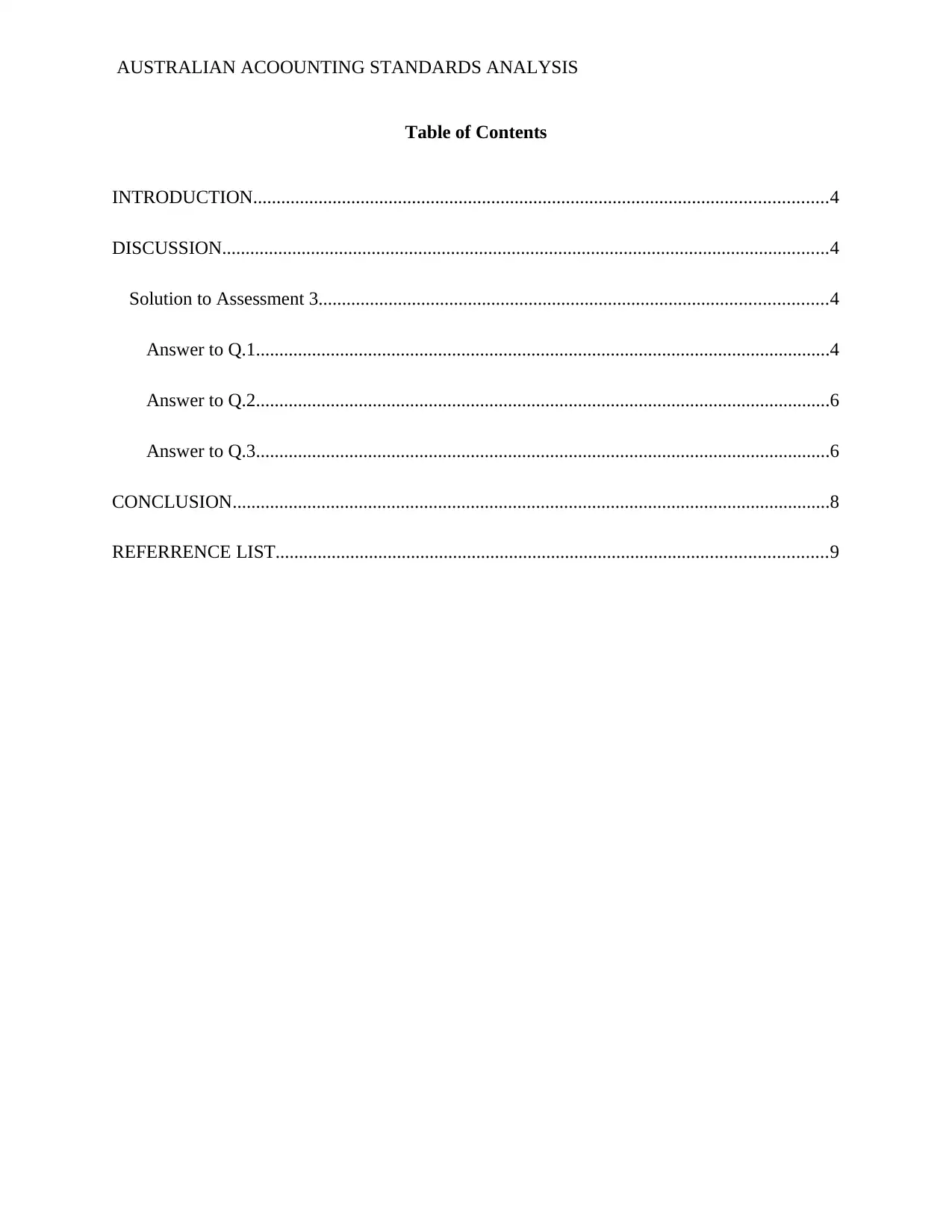
AUSTRALIAN ACOOUNTING STANDARDS ANALYSIS
Table of Contents
INTRODUCTION...........................................................................................................................4
DISCUSSION..................................................................................................................................4
Solution to Assessment 3.............................................................................................................4
Answer to Q.1...........................................................................................................................4
Answer to Q.2...........................................................................................................................6
Answer to Q.3...........................................................................................................................6
CONCLUSION................................................................................................................................8
REFERRENCE LIST......................................................................................................................9
Table of Contents
INTRODUCTION...........................................................................................................................4
DISCUSSION..................................................................................................................................4
Solution to Assessment 3.............................................................................................................4
Answer to Q.1...........................................................................................................................4
Answer to Q.2...........................................................................................................................6
Answer to Q.3...........................................................................................................................6
CONCLUSION................................................................................................................................8
REFERRENCE LIST......................................................................................................................9
⊘ This is a preview!⊘
Do you want full access?
Subscribe today to unlock all pages.

Trusted by 1+ million students worldwide
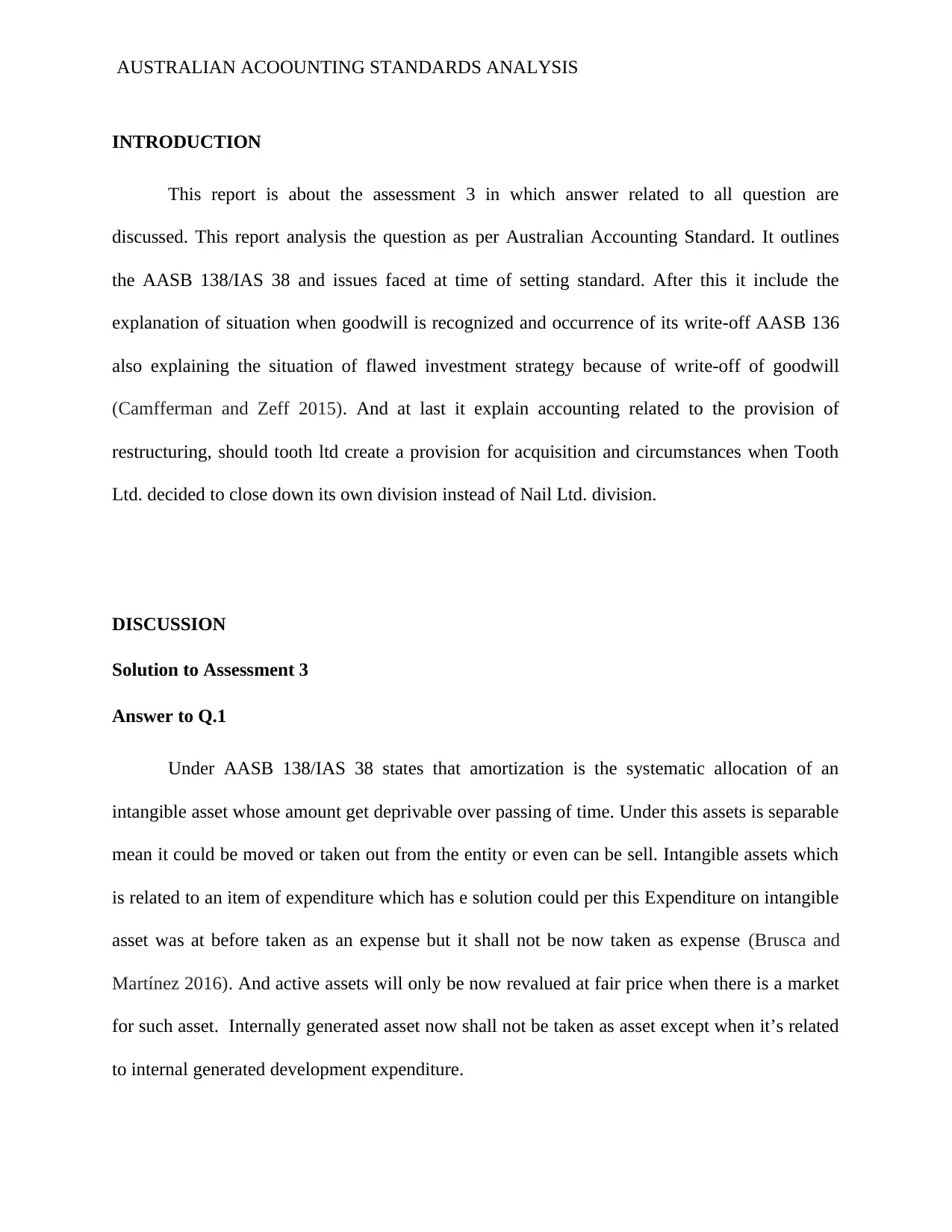
AUSTRALIAN ACOOUNTING STANDARDS ANALYSIS
INTRODUCTION
This report is about the assessment 3 in which answer related to all question are
discussed. This report analysis the question as per Australian Accounting Standard. It outlines
the AASB 138/IAS 38 and issues faced at time of setting standard. After this it include the
explanation of situation when goodwill is recognized and occurrence of its write-off AASB 136
also explaining the situation of flawed investment strategy because of write-off of goodwill
(Camfferman and Zeff 2015). And at last it explain accounting related to the provision of
restructuring, should tooth ltd create a provision for acquisition and circumstances when Tooth
Ltd. decided to close down its own division instead of Nail Ltd. division.
DISCUSSION
Solution to Assessment 3
Answer to Q.1
Under AASB 138/IAS 38 states that amortization is the systematic allocation of an
intangible asset whose amount get deprivable over passing of time. Under this assets is separable
mean it could be moved or taken out from the entity or even can be sell. Intangible assets which
is related to an item of expenditure which has e solution could per this Expenditure on intangible
asset was at before taken as an expense but it shall not be now taken as expense (Brusca and
Martínez 2016). And active assets will only be now revalued at fair price when there is a market
for such asset. Internally generated asset now shall not be taken as asset except when it’s related
to internal generated development expenditure.
INTRODUCTION
This report is about the assessment 3 in which answer related to all question are
discussed. This report analysis the question as per Australian Accounting Standard. It outlines
the AASB 138/IAS 38 and issues faced at time of setting standard. After this it include the
explanation of situation when goodwill is recognized and occurrence of its write-off AASB 136
also explaining the situation of flawed investment strategy because of write-off of goodwill
(Camfferman and Zeff 2015). And at last it explain accounting related to the provision of
restructuring, should tooth ltd create a provision for acquisition and circumstances when Tooth
Ltd. decided to close down its own division instead of Nail Ltd. division.
DISCUSSION
Solution to Assessment 3
Answer to Q.1
Under AASB 138/IAS 38 states that amortization is the systematic allocation of an
intangible asset whose amount get deprivable over passing of time. Under this assets is separable
mean it could be moved or taken out from the entity or even can be sell. Intangible assets which
is related to an item of expenditure which has e solution could per this Expenditure on intangible
asset was at before taken as an expense but it shall not be now taken as expense (Brusca and
Martínez 2016). And active assets will only be now revalued at fair price when there is a market
for such asset. Internally generated asset now shall not be taken as asset except when it’s related
to internal generated development expenditure.
Paraphrase This Document
Need a fresh take? Get an instant paraphrase of this document with our AI Paraphraser
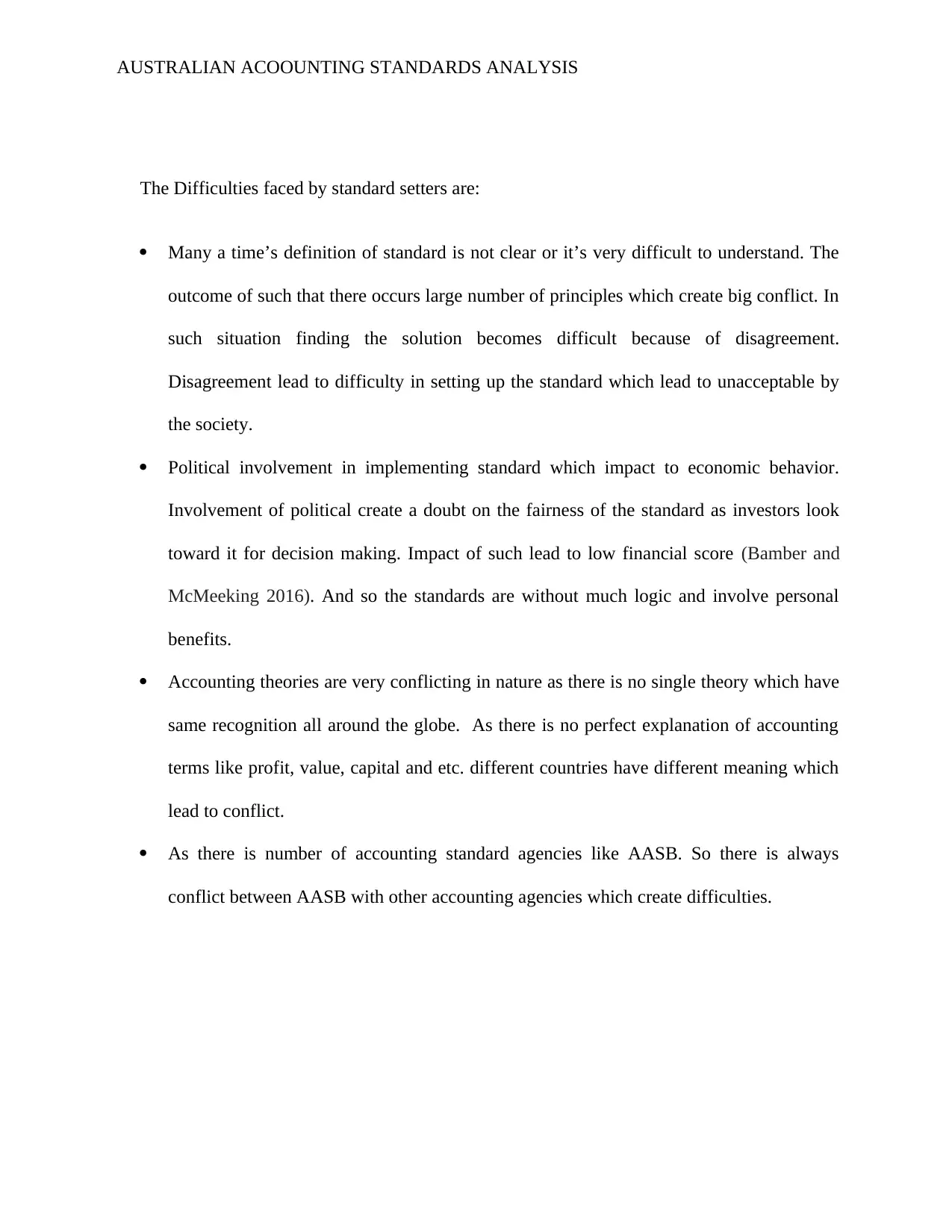
AUSTRALIAN ACOOUNTING STANDARDS ANALYSIS
The Difficulties faced by standard setters are:
Many a time’s definition of standard is not clear or it’s very difficult to understand. The
outcome of such that there occurs large number of principles which create big conflict. In
such situation finding the solution becomes difficult because of disagreement.
Disagreement lead to difficulty in setting up the standard which lead to unacceptable by
the society.
Political involvement in implementing standard which impact to economic behavior.
Involvement of political create a doubt on the fairness of the standard as investors look
toward it for decision making. Impact of such lead to low financial score (Bamber and
McMeeking 2016). And so the standards are without much logic and involve personal
benefits.
Accounting theories are very conflicting in nature as there is no single theory which have
same recognition all around the globe. As there is no perfect explanation of accounting
terms like profit, value, capital and etc. different countries have different meaning which
lead to conflict.
As there is number of accounting standard agencies like AASB. So there is always
conflict between AASB with other accounting agencies which create difficulties.
The Difficulties faced by standard setters are:
Many a time’s definition of standard is not clear or it’s very difficult to understand. The
outcome of such that there occurs large number of principles which create big conflict. In
such situation finding the solution becomes difficult because of disagreement.
Disagreement lead to difficulty in setting up the standard which lead to unacceptable by
the society.
Political involvement in implementing standard which impact to economic behavior.
Involvement of political create a doubt on the fairness of the standard as investors look
toward it for decision making. Impact of such lead to low financial score (Bamber and
McMeeking 2016). And so the standards are without much logic and involve personal
benefits.
Accounting theories are very conflicting in nature as there is no single theory which have
same recognition all around the globe. As there is no perfect explanation of accounting
terms like profit, value, capital and etc. different countries have different meaning which
lead to conflict.
As there is number of accounting standard agencies like AASB. So there is always
conflict between AASB with other accounting agencies which create difficulties.
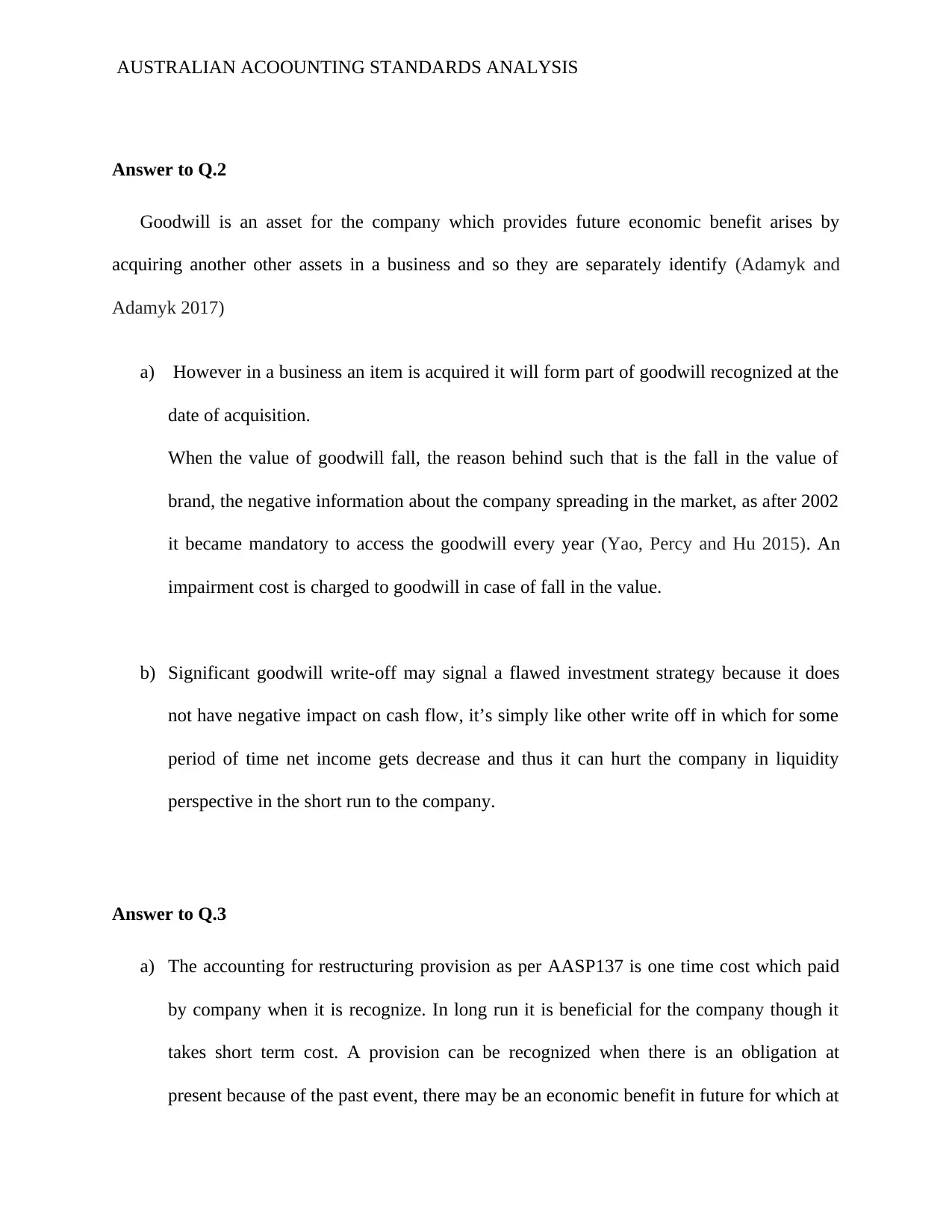
AUSTRALIAN ACOOUNTING STANDARDS ANALYSIS
Answer to Q.2
Goodwill is an asset for the company which provides future economic benefit arises by
acquiring another other assets in a business and so they are separately identify (Adamyk and
Adamyk 2017)
a) However in a business an item is acquired it will form part of goodwill recognized at the
date of acquisition.
When the value of goodwill fall, the reason behind such that is the fall in the value of
brand, the negative information about the company spreading in the market, as after 2002
it became mandatory to access the goodwill every year (Yao, Percy and Hu 2015). An
impairment cost is charged to goodwill in case of fall in the value.
b) Significant goodwill write-off may signal a flawed investment strategy because it does
not have negative impact on cash flow, it’s simply like other write off in which for some
period of time net income gets decrease and thus it can hurt the company in liquidity
perspective in the short run to the company.
Answer to Q.3
a) The accounting for restructuring provision as per AASP137 is one time cost which paid
by company when it is recognize. In long run it is beneficial for the company though it
takes short term cost. A provision can be recognized when there is an obligation at
present because of the past event, there may be an economic benefit in future for which at
Answer to Q.2
Goodwill is an asset for the company which provides future economic benefit arises by
acquiring another other assets in a business and so they are separately identify (Adamyk and
Adamyk 2017)
a) However in a business an item is acquired it will form part of goodwill recognized at the
date of acquisition.
When the value of goodwill fall, the reason behind such that is the fall in the value of
brand, the negative information about the company spreading in the market, as after 2002
it became mandatory to access the goodwill every year (Yao, Percy and Hu 2015). An
impairment cost is charged to goodwill in case of fall in the value.
b) Significant goodwill write-off may signal a flawed investment strategy because it does
not have negative impact on cash flow, it’s simply like other write off in which for some
period of time net income gets decrease and thus it can hurt the company in liquidity
perspective in the short run to the company.
Answer to Q.3
a) The accounting for restructuring provision as per AASP137 is one time cost which paid
by company when it is recognize. In long run it is beneficial for the company though it
takes short term cost. A provision can be recognized when there is an obligation at
present because of the past event, there may be an economic benefit in future for which at
⊘ This is a preview!⊘
Do you want full access?
Subscribe today to unlock all pages.

Trusted by 1+ million students worldwide
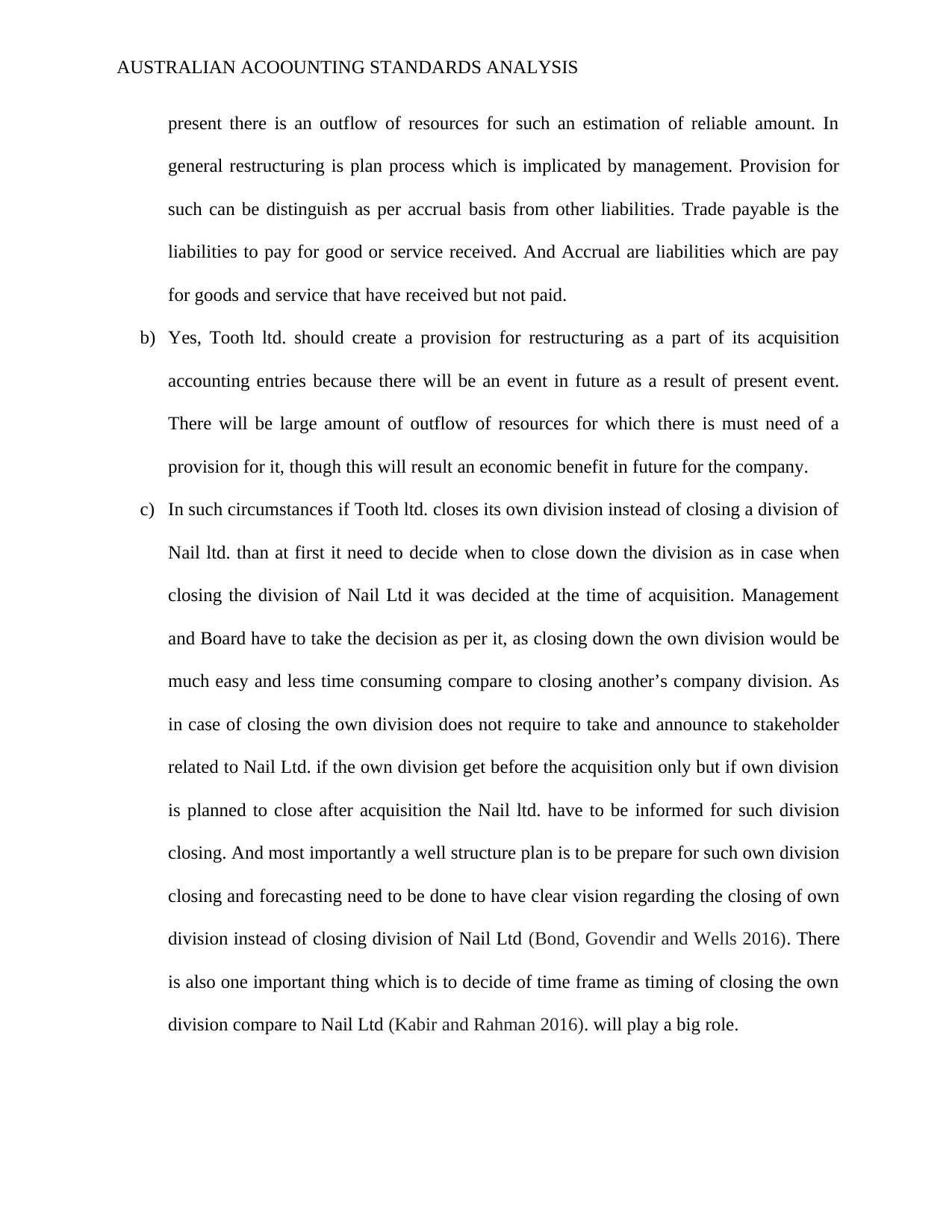
AUSTRALIAN ACOOUNTING STANDARDS ANALYSIS
present there is an outflow of resources for such an estimation of reliable amount. In
general restructuring is plan process which is implicated by management. Provision for
such can be distinguish as per accrual basis from other liabilities. Trade payable is the
liabilities to pay for good or service received. And Accrual are liabilities which are pay
for goods and service that have received but not paid.
b) Yes, Tooth ltd. should create a provision for restructuring as a part of its acquisition
accounting entries because there will be an event in future as a result of present event.
There will be large amount of outflow of resources for which there is must need of a
provision for it, though this will result an economic benefit in future for the company.
c) In such circumstances if Tooth ltd. closes its own division instead of closing a division of
Nail ltd. than at first it need to decide when to close down the division as in case when
closing the division of Nail Ltd it was decided at the time of acquisition. Management
and Board have to take the decision as per it, as closing down the own division would be
much easy and less time consuming compare to closing another’s company division. As
in case of closing the own division does not require to take and announce to stakeholder
related to Nail Ltd. if the own division get before the acquisition only but if own division
is planned to close after acquisition the Nail ltd. have to be informed for such division
closing. And most importantly a well structure plan is to be prepare for such own division
closing and forecasting need to be done to have clear vision regarding the closing of own
division instead of closing division of Nail Ltd (Bond, Govendir and Wells 2016). There
is also one important thing which is to decide of time frame as timing of closing the own
division compare to Nail Ltd (Kabir and Rahman 2016). will play a big role.
present there is an outflow of resources for such an estimation of reliable amount. In
general restructuring is plan process which is implicated by management. Provision for
such can be distinguish as per accrual basis from other liabilities. Trade payable is the
liabilities to pay for good or service received. And Accrual are liabilities which are pay
for goods and service that have received but not paid.
b) Yes, Tooth ltd. should create a provision for restructuring as a part of its acquisition
accounting entries because there will be an event in future as a result of present event.
There will be large amount of outflow of resources for which there is must need of a
provision for it, though this will result an economic benefit in future for the company.
c) In such circumstances if Tooth ltd. closes its own division instead of closing a division of
Nail ltd. than at first it need to decide when to close down the division as in case when
closing the division of Nail Ltd it was decided at the time of acquisition. Management
and Board have to take the decision as per it, as closing down the own division would be
much easy and less time consuming compare to closing another’s company division. As
in case of closing the own division does not require to take and announce to stakeholder
related to Nail Ltd. if the own division get before the acquisition only but if own division
is planned to close after acquisition the Nail ltd. have to be informed for such division
closing. And most importantly a well structure plan is to be prepare for such own division
closing and forecasting need to be done to have clear vision regarding the closing of own
division instead of closing division of Nail Ltd (Bond, Govendir and Wells 2016). There
is also one important thing which is to decide of time frame as timing of closing the own
division compare to Nail Ltd (Kabir and Rahman 2016). will play a big role.
Paraphrase This Document
Need a fresh take? Get an instant paraphrase of this document with our AI Paraphraser
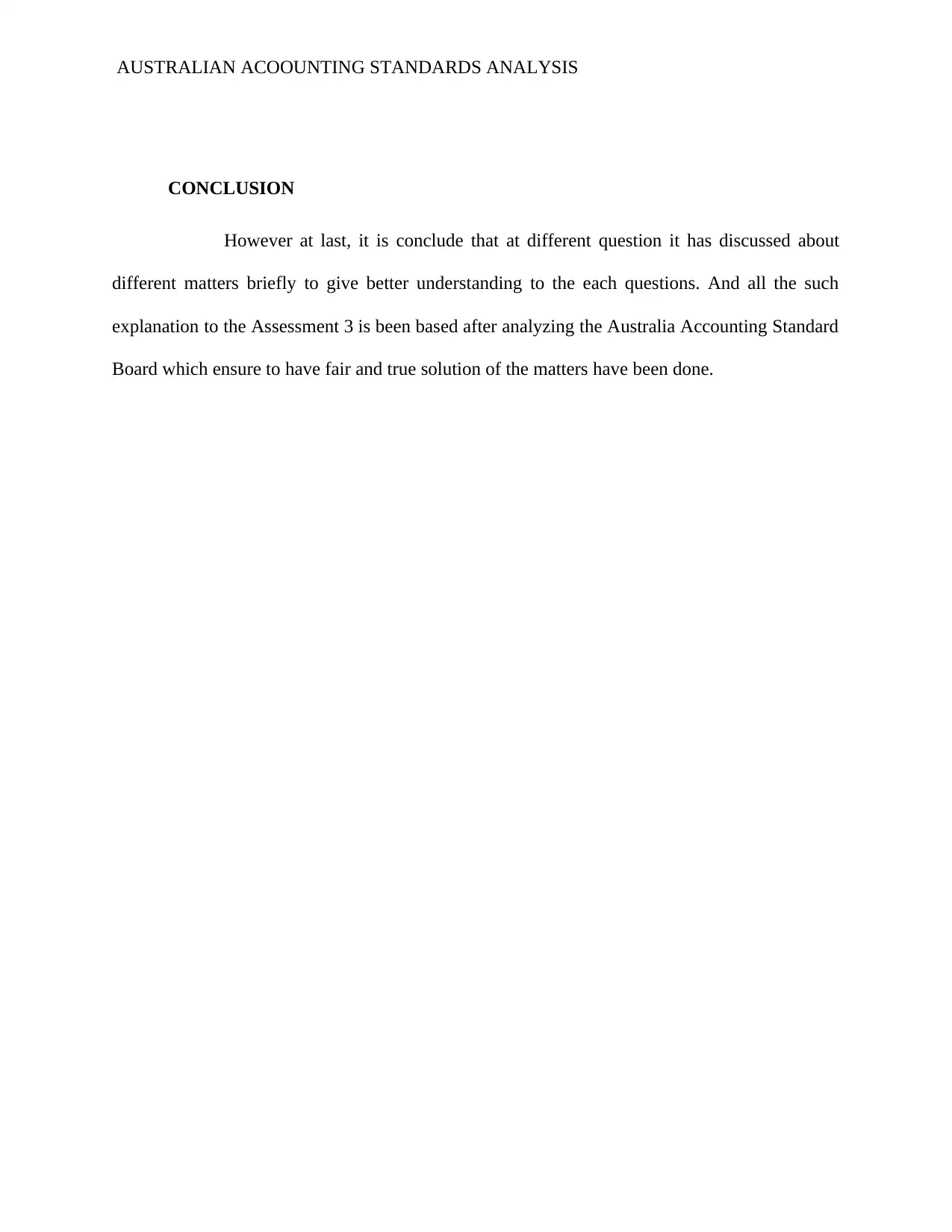
AUSTRALIAN ACOOUNTING STANDARDS ANALYSIS
CONCLUSION
However at last, it is conclude that at different question it has discussed about
different matters briefly to give better understanding to the each questions. And all the such
explanation to the Assessment 3 is been based after analyzing the Australia Accounting Standard
Board which ensure to have fair and true solution of the matters have been done.
CONCLUSION
However at last, it is conclude that at different question it has discussed about
different matters briefly to give better understanding to the each questions. And all the such
explanation to the Assessment 3 is been based after analyzing the Australia Accounting Standard
Board which ensure to have fair and true solution of the matters have been done.
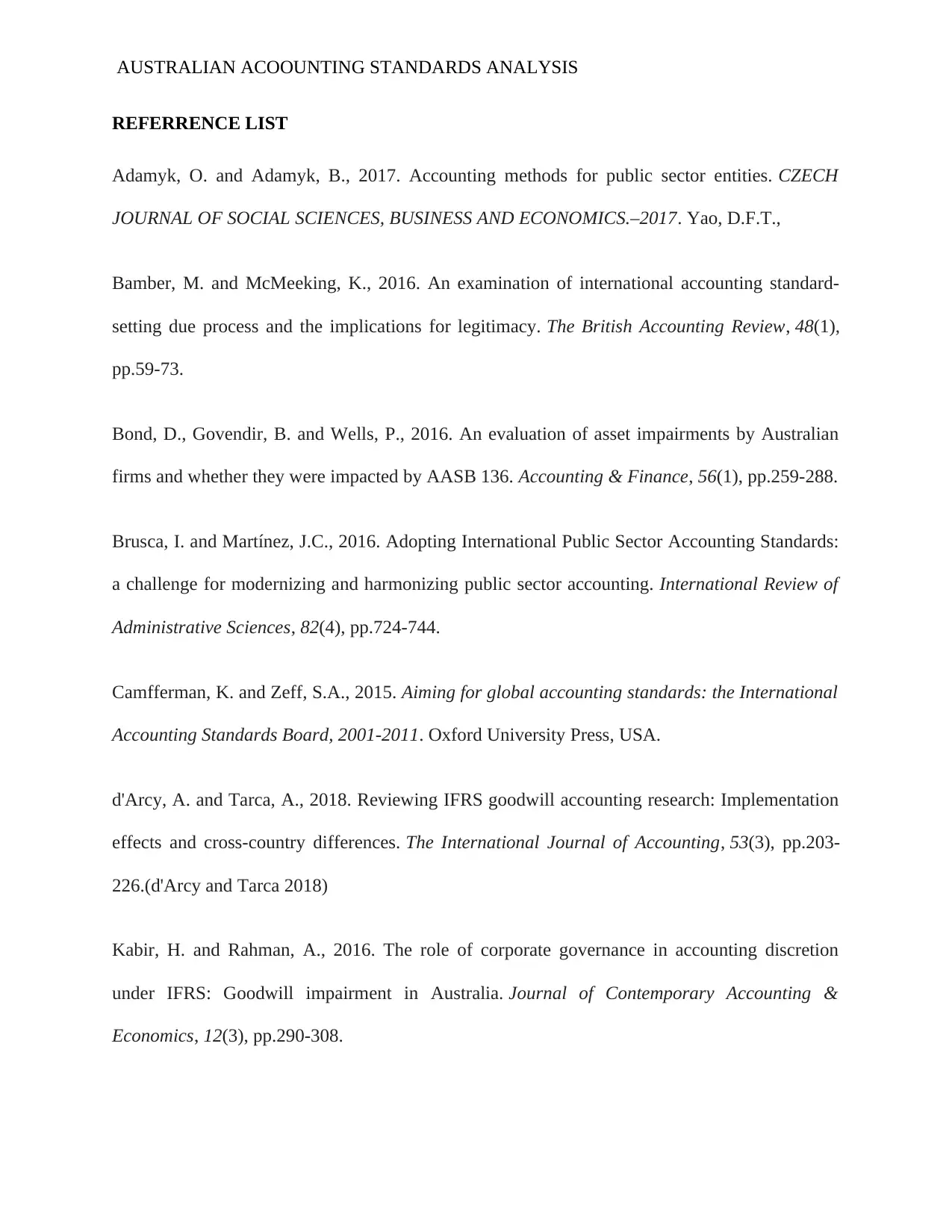
AUSTRALIAN ACOOUNTING STANDARDS ANALYSIS
REFERRENCE LIST
Adamyk, O. and Adamyk, B., 2017. Accounting methods for public sector entities. CZECH
JOURNAL OF SOCIAL SCIENCES, BUSINESS AND ECONOMICS.–2017. Yao, D.F.T.,
Bamber, M. and McMeeking, K., 2016. An examination of international accounting standard-
setting due process and the implications for legitimacy. The British Accounting Review, 48(1),
pp.59-73.
Bond, D., Govendir, B. and Wells, P., 2016. An evaluation of asset impairments by Australian
firms and whether they were impacted by AASB 136. Accounting & Finance, 56(1), pp.259-288.
Brusca, I. and Martínez, J.C., 2016. Adopting International Public Sector Accounting Standards:
a challenge for modernizing and harmonizing public sector accounting. International Review of
Administrative Sciences, 82(4), pp.724-744.
Camfferman, K. and Zeff, S.A., 2015. Aiming for global accounting standards: the International
Accounting Standards Board, 2001-2011. Oxford University Press, USA.
d'Arcy, A. and Tarca, A., 2018. Reviewing IFRS goodwill accounting research: Implementation
effects and cross-country differences. The International Journal of Accounting, 53(3), pp.203-
226.(d'Arcy and Tarca 2018)
Kabir, H. and Rahman, A., 2016. The role of corporate governance in accounting discretion
under IFRS: Goodwill impairment in Australia. Journal of Contemporary Accounting &
Economics, 12(3), pp.290-308.
REFERRENCE LIST
Adamyk, O. and Adamyk, B., 2017. Accounting methods for public sector entities. CZECH
JOURNAL OF SOCIAL SCIENCES, BUSINESS AND ECONOMICS.–2017. Yao, D.F.T.,
Bamber, M. and McMeeking, K., 2016. An examination of international accounting standard-
setting due process and the implications for legitimacy. The British Accounting Review, 48(1),
pp.59-73.
Bond, D., Govendir, B. and Wells, P., 2016. An evaluation of asset impairments by Australian
firms and whether they were impacted by AASB 136. Accounting & Finance, 56(1), pp.259-288.
Brusca, I. and Martínez, J.C., 2016. Adopting International Public Sector Accounting Standards:
a challenge for modernizing and harmonizing public sector accounting. International Review of
Administrative Sciences, 82(4), pp.724-744.
Camfferman, K. and Zeff, S.A., 2015. Aiming for global accounting standards: the International
Accounting Standards Board, 2001-2011. Oxford University Press, USA.
d'Arcy, A. and Tarca, A., 2018. Reviewing IFRS goodwill accounting research: Implementation
effects and cross-country differences. The International Journal of Accounting, 53(3), pp.203-
226.(d'Arcy and Tarca 2018)
Kabir, H. and Rahman, A., 2016. The role of corporate governance in accounting discretion
under IFRS: Goodwill impairment in Australia. Journal of Contemporary Accounting &
Economics, 12(3), pp.290-308.
⊘ This is a preview!⊘
Do you want full access?
Subscribe today to unlock all pages.

Trusted by 1+ million students worldwide

AUSTRALIAN ACOOUNTING STANDARDS ANALYSIS
Percy, M. and Hu, F., 2015. Fair value accounting for non-current assets and audit fees:
Evidence from Australian companies. Journal of Contemporary Accounting & Economics, 11(1),
pp.31-45.
Percy, M. and Hu, F., 2015. Fair value accounting for non-current assets and audit fees:
Evidence from Australian companies. Journal of Contemporary Accounting & Economics, 11(1),
pp.31-45.
1 out of 10
Related Documents
Your All-in-One AI-Powered Toolkit for Academic Success.
+13062052269
info@desklib.com
Available 24*7 on WhatsApp / Email
![[object Object]](/_next/static/media/star-bottom.7253800d.svg)
Unlock your academic potential
Copyright © 2020–2025 A2Z Services. All Rights Reserved. Developed and managed by ZUCOL.





